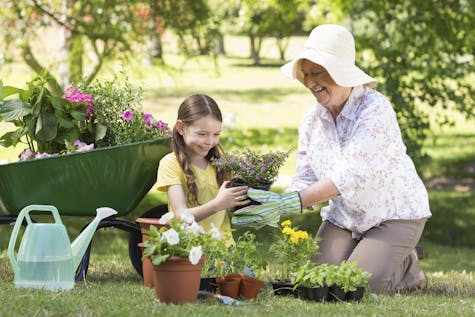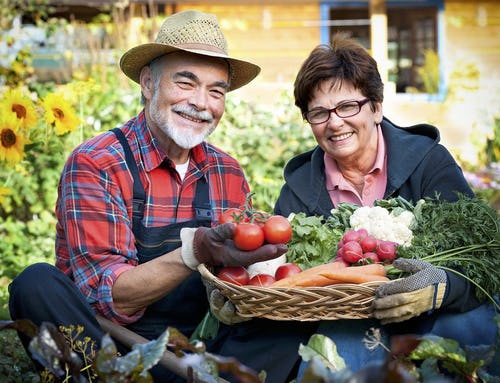Gardening is a wonderful activity to enjoy nature and the outdoors which provides many physical and health benefits. Although it may not get your heart pumping as other activities, lawn work and gardening are still a great way of staying physically active.
Gardening requires you to bend, squat, pull, drag, carry, and rake and till – all requiring muscle use. The simple activities of gardening strengthen bones and joints, keep your muscles strong, and help with increasing stamina and flexibility. It also helps increase your exposure to sunlight, which increases your vitamin D levels. Vitamin D is essential to keep your bones healthy, which keeps you pain and injury-free. Gardening can also be a great form of mindfulness meditation. It can be a great way to destress and unwind from our busy stressful daily routines. Lots of benefits!
Gardening Injuries
Gardening makes you susceptible to injury because it requires tasks such as lifting, pulling, pushing, and stooping. Most of us are not conditioned to perform these actions for extended periods of time. Your neck, back, shoulders and knees are the most prone to injury with gardening. Sustained poor postures like stooping, bending forward and kneeling, lifting heavy objects and repetitive movements put increased stress on your joints and can cause inflammation and pain.
- Muscle strains: A muscle strain is an over stretching or tearing of a muscle or tendon. Lower back, neck, and shoulder strains are common with gardening due to lifting, prolonged postures, and overhead trimming or pruning.
- Muscle sprains: An over stretching or tearing of a ligament. Sprains are most common in the ankle, but they can happen in any joint of the body. You can sprain your ankle or knee when you garden if you trip or fall or even step on uneven ground.
Tips for Avoiding Gardening Injuries:
Warm Up & Stretch:
- Perform a proper warm-up. You wouldn’t go for a 5-mile run or play a game of soccer without warming up, so why would you garden without warming up? Spend 10 minutes doing a warm-up including brisk walking for 3-5 minutes and stretches that target your neck, lower back and shoulders. A proper warm-up will increase the blood flow to your muscles, improve flexibility, and decrease the risk of straining your muscles.
Good Body Mechanics:
- Change Positions:
Be aware of proper positions and postures while you are gardening. It is important to change positions regularly while gardening to avoid unnecessary stress/strain on the body and to avoid muscles from getting tight and sore. You should alternate between sitting and standing positions every 30 minutes and limit any overhead chores to 5 minutes or less at a time.
- Proper Posture / Neutral Spine:
Maintaining your spine in neutral alignment is also very important to avoid excess stress on the muscles and ligaments of the neck and back.
Neutral alignment means that your spine stays in a straight line and you are not hunched over or looking down or up for an extended period of time. Planting or weeding in a half-kneeling position or sitting on a gardening stool are the best positions for spinal alignment. To decrease stress on your shoulders and back, you should avoid reaching out in front of you. Keep your work close to your body or use long- handled tools to aid in your activity to avoid over-stretching. If you are moving heavy objects such as bags of topsoil or rocks, consider using a wheelbarrow or a sled that you can pull or push them in to decrease stress on your joints. Lifting tasks should always be performed with the load close to your body and keeping a straight spine.
- Avoid Twisting Motions:
You should be minimizing twisting as much as possible by turning your body with the motion instead of keeping your body still. Furthermore, engaging your core will help protect your back and keep you stable during some of the hardest actions.
- Use Your Legs:
When picking up objects, make sure you squat down to the appropriate level and lift with your legs, not just using your arms, shoulders, and back. Not only does this help protect your back from pain, but it also helps with balance and stability.

- Invest in gardening tools and equipment that makes activity easier /safer:
There are many ergonomic tools on the market which are designed to help you keep proper body alignment. Go to your local hardware store and try them out because there is no “one size fits all tool.” Make use of a wheelbarrow or garden cart to move heavy materials. Use a gardening rolling stool or scooter to sit on while working at a low level to avoid stooping bending or prolonged standing. Use knee pads or a kneeling pad while kneeling.
Get Some Help:
Get someone to help you move heavy objects when in doubt.
Ladder Safety:
Try to avoid use of ladders when trimming difficult to reach tree branch. Use an extendable pole saw or tree trimmer if available. If you must use a ladder make sure someone is there to help hold the ladder steady and always avoid standing on the top 2 rungs. When in doubt hire a professional tree trimming service / landscaping service for more difficult tasks to avoid putting yourself in a precarious / dangerous position on a ladder.

Listen to Your Body:
Make sure you listen to your body. If you start to feel pain at any point, stop and take a break. If the pain doesn’t go away, then perhaps wait until the next day to resume any gardening. It is never beneficial to push through pain when you are gardening. You should never garden for more than an hour at a time without a significant rest break. Muscles typically fatigue after a half hour of repetitive work, therefore you are at an increased risk of injury performing tasks with tired muscles. If you experience sharp pain or start to feel achy and sore, stop and rest. There is no rule that you have to complete a task in one day. Spread out manual labor over several weekends to avoid over stressing your body.
Stay Hydrated / Drink Water:
Water not only regulates your body temperature, it also helps lubricate joints and transport nutrients. If you’re not properly hydrated you could even experience fatigue, cramps and more. Thirst is actually a sign that you’re already getting dehydrated.
You want to prep before gardening or exercise. In fact, no matter what time you exercise, it’s important to hydrate throughout the day.
A good rule of thumb is to drink 2 cups of water in the hours before gardening, and then another cup 20 minutes in advance. During gardening / exercise, drink up to one cup every 20 minutes or so. After the workout, have a cup of water within half an hour.
Avoid Too Much Sun Exposure:
Covering up and using sunscreen can also help to reduce your risk of getting sunburn, skin cancer, and early signs of skin aging, including age spots and wrinkles.
- Cover up. Wear gloves, a shirt with long sleeves, pants, socks, and shoes that cover your feet. Dermatologists also recommend wearing a wide-brimmed hat and sunglasses while outdoors.
- Use sunscreen. To protect your skin from the sun, you’ll also want to apply sunscreen. Use a Broad-Spectrum SPF 30 or higher sunscreen that is water resistant. Re-apply sunscreen every 2 hours to remain protected.
Keep a Cell Phone Near By In Case of Emergency
Just in case- but getting outdoors is healthy and fun!

